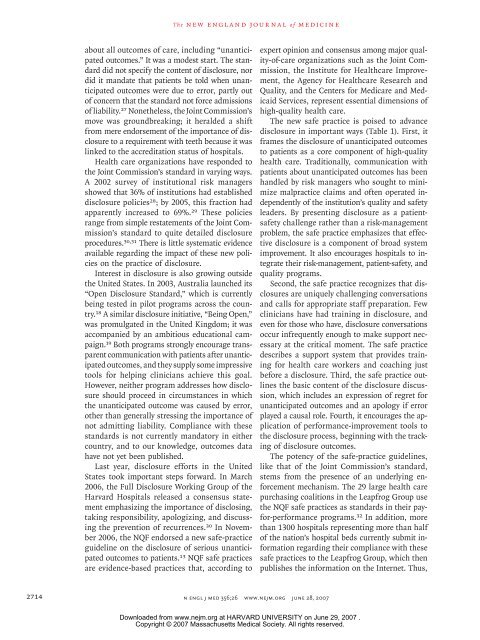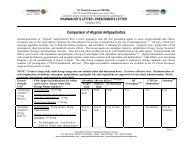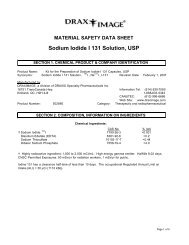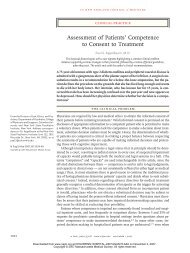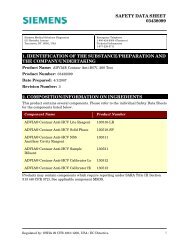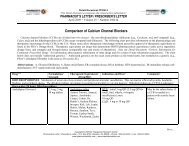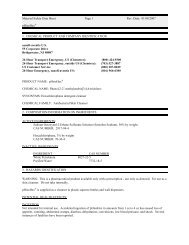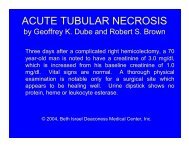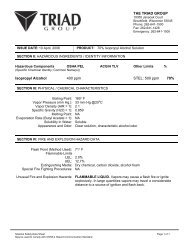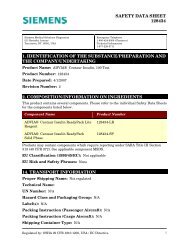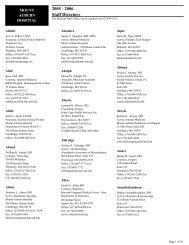Disclosing Harmful Medical Errors to Patients - Harvard University
Disclosing Harmful Medical Errors to Patients - Harvard University
Disclosing Harmful Medical Errors to Patients - Harvard University
Create successful ePaper yourself
Turn your PDF publications into a flip-book with our unique Google optimized e-Paper software.
T h e n e w e ng l a nd j o u r na l o f m e dic i n eabout all outcomes of care, including “unanticipatedoutcomes.” It was a modest start. The standarddid not specify the content of disclosure, nordid it mandate that patients be <strong>to</strong>ld when unanticipatedoutcomes were due <strong>to</strong> error, partly ou<strong>to</strong>f concern that the standard not force admissionsof liability. 27 Nonetheless, the Joint Commission’smove was groundbreaking; it heralded a shiftfrom mere endorsement of the importance of disclosure<strong>to</strong> a requirement with teeth because it waslinked <strong>to</strong> the accreditation status of hospitals.Health care organizations have responded <strong>to</strong>the Joint Commission’s standard in varying ways.A 2002 survey of institutional risk managersshowed that 36% of institutions had establisheddisclosure policies 28 ; by 2005, this fraction hadapparently increased <strong>to</strong> 69%. 29 These policiesrange from simple restatements of the Joint Commission’sstandard <strong>to</strong> quite detailed disclosureprocedures. 30,31 There is little systematic evidenceavailable regarding the impact of these new policieson the practice of disclosure.Interest in disclosure is also growing outsidethe United States. In 2003, Australia launched its“Open Disclosure Standard,” which is currentlybeing tested in pilot programs across the country.18 A similar disclosure initiative, “Being Open,”was promulgated in the United Kingdom; it wasaccompanied by an ambitious educational campaign.19 Both programs strongly encourage transparentcommunication with patients after unanticipatedoutcomes, and they supply some impressive<strong>to</strong>ols for helping clinicians achieve this goal.However, neither program addresses how disclosureshould proceed in circumstances in whichthe unanticipated outcome was caused by error,other than generally stressing the importance ofnot admitting liability. Compliance with thesestandards is not currently manda<strong>to</strong>ry in eithercountry, and <strong>to</strong> our knowledge, outcomes datahave not yet been published.Last year, disclosure efforts in the UnitedStates <strong>to</strong>ok important steps forward. In March2006, the Full Disclosure Working Group of the<strong>Harvard</strong> Hospitals released a consensus statementemphasizing the importance of disclosing,taking responsibility, apologizing, and discussingthe prevention of recurrences. 30 In November2006, the NQF endorsed a new safe-practiceguideline on the disclosure of serious unanticipatedoutcomes <strong>to</strong> patients. 13 NQF safe practicesare evidence-based practices that, according <strong>to</strong>expert opinion and consensus among major quality-of-careorganizations such as the Joint Commission,the Institute for Healthcare Improvement,the Agency for Healthcare Research andQuality, and the Centers for Medicare and MedicaidServices, represent essential dimensions ofhigh-quality health care.The new safe practice is poised <strong>to</strong> advancedisclosure in important ways (Table 1). First, itframes the disclosure of unanticipated outcomes<strong>to</strong> patients as a core component of high-qualityhealth care. Traditionally, communication withpatients about unanticipated outcomes has beenhandled by risk managers who sought <strong>to</strong> minimizemalpractice claims and often operated independentlyof the institution’s quality and safetyleaders. By presenting disclosure as a patientsafetychallenge rather than a risk-managementproblem, the safe practice emphasizes that effectivedisclosure is a component of broad systemimprovement. It also encourages hospitals <strong>to</strong> integratetheir risk-management, patient-safety, andquality programs.Second, the safe practice recognizes that disclosuresare uniquely challenging conversationsand calls for appropriate staff preparation. Fewclinicians have had training in disclosure, andeven for those who have, disclosure conversationsoccur infrequently enough <strong>to</strong> make support necessaryat the critical moment. The safe practicedescribes a support system that provides trainingfor health care workers and coaching justbefore a disclosure. Third, the safe practice outlinesthe basic content of the disclosure discussion,which includes an expression of regret forunanticipated outcomes and an apology if errorplayed a causal role. Fourth, it encourages the applicationof performance-improvement <strong>to</strong>ols <strong>to</strong>the disclosure process, beginning with the trackingof disclosure outcomes.The potency of the safe-practice guidelines,like that of the Joint Commission’s standard,stems from the presence of an underlying enforcementmechanism. The 29 large health carepurchasing coalitions in the Leapfrog Group usethe NQF safe practices as standards in their payfor-performanceprograms. 32 In addition, morethan 1300 hospitals representing more than halfof the nation’s hospital beds currently submit informationregarding their compliance with thesesafe practices <strong>to</strong> the Leapfrog Group, which thenpublishes the information on the Internet. Thus,2714n engl j med 356;26 www.nejm.org june 28, 2007Downloaded from www.nejm.org at HARVARD UNIVERSITY on June 29, 2007 .Copyright © 2007 Massachusetts <strong>Medical</strong> Society. All rights reserved.


